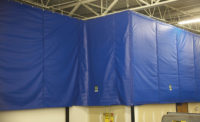I was the youngest man in the group and most of the other men were retired from the plants. Most of these men were hard of hearing, and when they spoke they almost shouted. Most responses were "what?" and "huh?"
You see, they had worked in these plants before hearing protection was required. After years of being around whistling steam and loud equipment they had lost their hearing. There is no doubt in my mind that the majority of the hearing loss was work-related. I am thankful that I have worn my hearing protection when I've been around loud noises.
Hard to enforce
Hearing protection is one of the harder pieces of personal protective equipment (PPE) to enforce. The problem is that the consequences of being around loud noises are delayed. If people noticed a loss in hearing every time they worked around noisy equipment, we as safety professionals wouldn't have to be reminding employees to wear their hearing protection.No one wants to appear to be older than his or her years. This explains why there are hair implants, hair dye, plastic surgery and a vast array of other products that help us appear younger. On the other hand, if you wish to appear older (which, of course, no one wants), you can work around loud noises without hearing protection. As you lose your hearing you will start to talk loud because you can't even hear your own voice, and you'll get really good at using the word "what?" as a response to peoples' questions.
Of course, no one wants to lose his or her hearing. So why is a hearing protection program so difficult to enforce? Let's think about why people wouldn't wear their hearing protection when it is required.
1) They're unbelievers
I firmly believe that people who don't wear their hearing protection don't believe it works. In a way, I can't blame them. When I wear my earplugs I can still hear, so how can that be protecting my hearing?The belief that the hearing protection works is even weaker when the worker is using it around sounds that aren't that high-pitched. For example, most people would not think that a lawnmower noise would harm your hearing. In fact, lawnmowers can be very loud, and when you take into effect the time spent mowing, they can be a hazard to your hearing.
If you have ever been around very high-pitched noises such as jet engines you will know that the noise is so loud that it actually hurts your ears. In this case the worker easily recognizes the need.
2) Equipment is uncomfortable
Earplugs and muffs can be uncomfortable, especially until a person gets used to wearing them. Remember when you were a child and had an earache? If your mom was like mine she would drip oil into your ear and then stick a cotton ball in it. That cotton always felt foreign and would usually bother me more than the original ache. (Who knows, maybe her strategy was to get my mind off the earache and onto the cotton!)Sponge earplugs are like that cotton ball. When a person first uses them they will feel uncomfortable, and the user will want to keep pulling them out. On the other hand, after a person wears them for a few years they don't even notice them. In most cases it is simply a habit. Of course, there are other types of plugs and muffs that can be tried for people who have continued difficulty. It is a good policy to offer several types of hearing protection and let the employee pick the type that is the best for him or her.
Comfort is sometimes related to training. A person may simply be using the hearing protection improperly. Putting the plugs in too far or having muffs that are too small can cause discomfort.
3) Where's the training?
If there is no hearing protection training class in place then there is no hearing protection program. Companies will sometimes buy boxes of earplugs, pass them out and tell everyone to wear them - and think they have a program in place. This is certainly no program.Training is the foundation of a good hearing protection program.
It has been many years since I attended my first hearing protection training class. Yet I can still picture the slide that showed the hairs inside the ear and how they bend from sound, and that high levels of sound over extended periods will bend the hairs down to a point where they won't stand back up. That slide has controlled my behavior as it relates to hearing protection. I have never hesitated to wear hearing protection since that time.
Training should include:
- A review of how the ear works and how noise levels affect hearing.
- Examples of typical equipment and their related sound levels. This gives the student an opportunity to understand how noise affects the ear and a person's hearing.
- review of how the hearing protection is properly used, including hygiene. Don't assume that employees understand these two items.
- Yearly training classes. Update your training materials so that the same training presentation isn't repeated each year.
- Management participation. Make sure that your management team takes an active part in the training, both as students and helping with the training.
Formulate a program
The heart of a noise protection/prevention program is, quite obviously, the prevention of noise. Often the noise that is above 85 dB can be muffled. Remember that prevention is the best policy.As you look at your hearing protection program try to identify what is causing the noise and then try to reduce that noise. Oftentimes simple insulation or mufflers will do the trick. Engineering the noise out of the system should be your first approach.
If the noise cannot be reduced then see if the workforce can be moved. Let's say you have an assembly line next to a large cooling tower that has fans producing 95 dB. The cooling tower can't be enclosed, but you may be able to move the assembly line to an area away from the noise.
If you can't engineer a sound reduction and you can't relocate the worker then you will have to institute a noise reduction program.
Let's protect our workers' hearing so that when they retire they will be able to hear their grandchildren's voices - and be able to respond to them with more than just "huh?" and "what?"
SIDEBAR: How loud is your job?
Noise exposures greater than 85 dB may cause hearing loss. General estimates of some work-related noises, according to the National Institute for Occupational Safety and Health (NIOSH), are listed below. Where does your job fit in?
- Rocket launch - 180 dB
- 12-gauge shotgun - 165 dB
- Jet engine at takeoff - 140 dB
- Ambulance siren - 120 dB
- Pneumatic percussion drill - 119 dB
- Hammer drill - 114 dB
- Chain saw - 110 dB
- Continuous miner - 108 dB
- Bulldozer; spray painter - 105 dB
- Impact wrench - 103 dB
- Hand drill - 98 dB
- Tractor - 96 dB
- Belt sander - 93 dB
- Hair dryer; power lawnmower - 90 dB
- Ringing telephone - 80 dB
- Normal conversation - 60 dB

